“Simca war die Kapelle. Citroën war das Kammerorchester. Renault war das Symphonieorchester und Fiat waren die Philharmoniker.”
– Robert Opron
“Simca était l’orphéon. Citroën etait l’orchestre de chambre. Renault c’était l’orchestre symphonique et Fiat c’était le philharmonique.”
– Robert Opron
“Simca was the orpheon. Citroën was the chamber orchestra. Renault was the symphony orchestra, and Fiat was the philharmonic orchestra.”
– Robert Opron
1958
Concept / Studie
1 Ex.
Design: Robert Opron
Im Frühjahr des Jahres 1958 lädt das belgische Jugendmagazin „Tintin“ (deutsch: “Tim und Struppi”) französische Automobilhersteller ein, ihre Zukunftsvision für ein Auto des Jahres 1980 zu entwerfen. Tintin hat eine breite Leserschaft und wird auch von vielen Erwachsenen gelesen. Doch kein einziger Hersteller reagiert…
Robert Opron arbeitet seit einem Jahr bei Simca und erzählt seinem Nachbarn Pierre Guérin von dem Wettbewerb. Guérin ist ein Astronom und Astrophysiker am Pariser Observatorium und bittet Opron bei einem Aperitif dringend, seinen Arbeitgeber vom diesem bedeutsamen Projekts zu überzeugen. Noch während des Gespräches entsteht die Idee, als Zielzeit besser das Jahr 2000 für die automobile Zukunftsvision zu wählen, was von “Tintin” dankbar aufgegriffen wird.
Bei Simca ist Opron im Designzentrum seit 1957 angestellt und bislang nur mit kleineren Projekten wie Logos, Zierlisten oder Radkappen beschäftigt. Doch es gelingt ihm tatsächlich, die Geschäftsführung zu überzeugen, ein Auto für das Jahr 2000 zu entwickeln. Mit Unterstützung eines Kollegen entwirft er das zweisitzige Konzeptfahrzeug “Fulgur”, ein Prototyp entsteht in der Prototypenwerkstatt. Es ist mehr Raumschiff oder fliegende Untertasse, als Automobil und greift den damaligen Zeitgeist auf, der sich im Wesentlichen aus den neuesten Errungenschaften der Luft- und Raumfahrt definiert. Der kompakte wie stromlinienförmige Fulgur verzichtet völlig auf den damals beliebten Chromschmuck und zeigt bereits Oprons Vorliebe für fließende Formen.
Der Prototyp wird erstmalig am 17. Okotober 1958 zur Neueröffnung der Simca-Fabrik in Poissy im Besucher- und Ausstellungszentrum “Poissyrama” vorgestellt, zu der auch die Redaktion von Tintin eingeladen wird.
Tintin bringt am 11. Dezember 1958 einen illustrierten Artikel zum Fulgur, der es – gezeichnet von Antonio Parras – auch auf die Titelseite des Magazins “Vaillant” schafft. Tintin veröffentlicht bis April 1959 auch den 13-teiligen Comic „Les aventures de l’agent ‚P.60′: Die Affäre Fulgur“, der sich mit dem Entstehen der Studie beschäftigt. Fulgur steht noch 1959 auf den Autosalons von Genf und Paris Welch eine Werbung für Simca!
Avantgardistische Fulgur-Technik
Allein die Liste der vorhergesehenen Funktionen ist bemerkenswert und zeugt von Oprons Weitsicht und Fantasie. Der Fulgur sollte von einem Sprachcomputer gesteuert werden und über ein Differenzial-Radar zur kontinuierlichen Überwachung der Straße verfügen, um das Fahrzeug bei Hindernissen automatisch anzuhalten. Das Lenkrad ähnelte dem Steuerknüppel eines Flugzeugs und wäre von Kontrolltürmen an den Straßen gesteuert worden.
Zentrales Element des Armaturenbrett war ein klar und ergonomisch gezeichneter Radarschirm. Die beiden über Luftzuführung klimatisierten, in Länge und Neigung individuell verstellbaren Sitze sind ganz im Space Age Stil gehalten, V-förmige „Stabilisierungsflossen“ als Leitwerk mit Steuervorrichtung sollen für die notwendige Stabilität sorgen.
Auf Autobahnen soll der Fulgur die Energie für seine beiden in den Hinterrädern integrierten Motoren induktiv über die Fahrbahnen bekommen. Abseits großer Magistralen hätten alternativ sechs Brennstoffzellen für Energie gesorgt, selbst ein austauschbarer Strontium-Mini-Reaktor war vorgesehen. So sollten beeindruckende 5.000 Kilometer Reichweite ohne Tankstopp möglich sein. Für außergewöhnlichen Fahrkomfort sorgte eine adaptive, elektromagnetische Federung genauso wie stabilisierende Kreisel oder geschwindigkeitsabhängige Leuchtweite der Scheinwerfer. Die Passagiere werden durch eine fast halbkugelförmige „Strahlenfilter-Haube“ vor dem schädlichen UV-Licht geschützt und genießen dennoch perfekten Rundumblick.
Imageträger für eine moderne Marke Simca
Am 26. Januar 1959 veranstaltet Simca in Paris in der Nähe des Place de l’Étoile eine Pressepräsentation des Fahrzeugs, nicht weit vom Simca Vedette-Kundenversuchscenter entfernt, mit zwei Berühmtheiten der Zeit: der Schauspielerin, Model und Fallschirmspringerin Colette Duval und ihrem Partner, Stuntman und Schauspieler Gilbert-Yves de la Mare de la Villenaise de Chenevarin. Das Auto wird dann auf die Straße nahe Paris gebracht, begleitet von der Gendarmerie, und inszeniert, um weitere dynamische Aufnahmen für die Presse zu machen.
Der Prototyp wird 1959 auf dem Genfer Automobilsalon präsentiert und geht dann auf Tournee, um in einigen wichtigen Simca-Verkaufsstellen in Frankreich ausgestellt zu werden.
… und Simca in Nordamerika
Simca produziert seine Autos in dreizehn Ländern und exportiert seit den frühen 50er Jahren in die USA. Im Jahr 1958 erwirbt das amerikanische Unternehmen Chrysler 15% des Kapitals und wird offizieller Vertriebspartner der Marke für Nordamerika. 20.000 Simcas werden im Jahr 1959 exportiert
Der Fulgur überquert den Atlantik wie seine kleinen Schwestern und startet sein letztes mediales Abenteuer.In St. Petersburg (USA) wird er am 3. Dezember 1959 auf der Foreign & Sports Car Show präsentiert, gefolgt von Ausstellungen in Washington, D.C., Miami, Detroit, Kansas City. Der Höhepunkt ist auf der International Automobile Show in New York, wo er im April 1960 auf dem Stand der Marke im aktuellen amerikanischen Stil, weiß mit blauen Streifen auf der Motorhaube, zu sehen ist, gefolgt von einer Präsentation im Mai 1960 in Montreal/Kanada; auf der Chicago Auto Show im Februar 1961 neben dem P60 auf dem Simca-Stand; es heißt, er habe es sogar bis Tokio geschafft.
Vor allem aber wird Citroën-Designchef Flaminio Bertoni auf den Fulgur und seinen Schöpfer Robert Opron aufmerksam. Als sich Opron dann 1962 bei Citroën bewirbt, ist er dort schon kein Unbekannter mehr.
Trotz bahnbrechender Ideen und seines spektakulären Auftritts verschwindet der Fulgur bald in der Versenkung, das Konzeptfahrzeug wird einige Jahre später verschrottet. Doch bis heute steht ein Aschenbecher in Form des Simca Fulgur im verwaisten Arbeitszimmer von Robert Opron und erinnert an dessen Durchbruch als Automobildesigner.
Au printemps 1958, le magazine belge pour la jeunesse “Tintin” (en français : Tintin et Milou) invite les constructeurs automobiles français à présenter leur vision de l’avenir pour une voiture de l’année 1980. Tintin a un large lectorat et est également lu par de nombreux adultes. Mais aucun constructeur ne réagit…
Robert Opron travaille chez Simca depuis un an et parle à son voisin Pierre Guérin du concours. Guérin est astronome et astrophysicien à l’Observatoire de Paris et, lors d’un apéritif, demande instamment à Opron de convaincre son employeur de ce projet important. L’idée de choisir l’année 2000 comme moment cible pour la vision automobile émerge pendant la conversation, ce qui est favorablement accueilli par “Tintin”.
Chez Simca, Opron travaille au centre de design depuis 1957, s’occupant jusqu’à présent de petits projets tels que des logos, des garnitures ou des enjoliveurs. Cependant, il parvient à persuader la direction de développer une voiture pour l’année 2000. Avec le soutien d’un collègue, il conçoit le prototype à deux places “Fulgur”, et un prototype est créé dans l’atelier de prototypes. Il ressemble davantage à un vaisseau spatial ou une soucoupe volante qu’à une voiture et capte l’esprit du temps, défini principalement par les dernières réalisations de l’aviation et de l’astronautique. Compact et profilé, le Fulgur se passe complètement des ornements chromés alors populaires, révélant déjà la préférence d’Opron pour des formes fluides.
Le prototype est présenté pour la première fois le 17 octobre 1958 à la réouverture de l’usine Simca à Poissy, dans le centre de visiteurs et d’expositions “Poissyrama”, auquel l’équipe éditoriale de Tintin est également invitée.
Le 11 décembre 1958, Tintin publie un article illustré sur le Fulgur, qui, dessiné par Antonio Parras, parvient même à la une du magazine “Vaillant”. Jusqu’en avril 1959, Tintin publie également la bande dessinée en 13 parties “Les aventures de l’agent ‘P.60’: L’affaire Fulgur”, qui traite de la création de l’étude. Fulgur est toujours présent en 1959 aux salons de l’automobile de Genève et de Paris – quelle publicité pour Simca !
Technologie avant-gardiste du Fulgur
Rien que la liste des fonctionnalités prévues est remarquable et témoigne de la clairvoyance et de l’imagination d’Opron. Le Fulgur devait être piloté par un ordinateur vocal et équipé d’un radar différentiel pour une surveillance continue de la route afin d’arrêter automatiquement le véhicule en cas d’obstacles. Le volant ressemblait au manche de commande d’un avion et aurait été contrôlé par des tours de contrôle le long des routes.
L’élément central du tableau de bord était un écran radar clair et ergonomique. Les sièges sont de style Space Age, des “ailerons de stabilisation” en forme de V servant d’empennage avec dispositif de commande devaient assurer la stabilité nécessaire.
Sur les autoroutes, le Fulgur devait recevoir de l’énergie pour ses deux moteurs intégrés dans les roues arrière de manière inductive depuis la route. Alternativement, loin des grandes voies, six piles à combustible auraient fourni de l’énergie, et même un mini-réacteur au strontium interchangeable était prévu. Cela devait permettre une impressionnante autonomie de 5.000 km sans ravitaillement. Pour un confort de conduite extraordinaire, une suspension électromagnétique adaptative assurait la stabilité, de même que des gyroscopes stabilisateurs ou un réglage de la portée des phares en fonction de la vitesse. Les 2 passagers étaient protégés des rayons UV nocifs par un capot “filtre à rayons” presque hémisphérique, tout en bénéficiant d’une vue parfaite tout autour ; ils pouvaient ajuster individuellement le siège climatisé pneumatiquement en longueur et en inclinaison.
Porteur d’image pour une marque Simca moderne
Le 26 janvier 1959, Simca organise une présentation presse du véhicule à Paris, près de la Place de l’Étoile, non loin du centre d’essai client Simca Vedette, avec deux célébrités de l’époque : l’actrice, mannequin et parachutiste Colette Duval et son partenaire, le cascadeur et acteur Gilbert-Yves de la Mare de la Villenaise de Chenevarin. La voiture est ensuite conduite sur la route près de Paris, accompagnée de la gendarmerie, et mise en scène pour réaliser d’autres prises de vue dynamiques destinées à la presse.
Le prototype est présenté en 1959 au Salon de l’automobile de Genève avant de partir en tournée pour être exposé dans quelques concessions Simca importantes en France.
…et dehors l’Europe…
Simca produit ses voitures dans treize pays et exporte aux États-Unis depuis le début des années 50. En 1958, l’entreprise américaine Chrysler acquiert 15% du capital et devient le distributeur officiel de la marque pour l’Amérique du Nord. En 1959, 20.000 Simcas sont exportées.
Le Fulgur traverse l’Atlantique comme ses petites sœurs et entame son dernier périple médiatique. À St. Petersburg (USA), il est présenté le 3 décembre 1959 à la Foreign & Sports Car Show, suivi d’expositions à Washington, D.C., Miami, Detroit et Kansas City. Le point culminant est à l’International Automobile Show de New York, où il est vu en avril 1960 sur le stand de la marque dans le style américain actuel, blanc avec des bandes bleues sur le capot. Suivent une présentation en mai 1960 à Montréal, au Canada ; à la Chicago Auto Show en février 1961, à côté du P60 sur le stand Simca; on dit même qu’il aurait atteint Tokyo.
Surtout, le directeur du design de Citroën, Flaminio Bertoni, remarque le Fulgur et son créateur Robert Opron. Lorsque Opron postule chez Citroën en 1962, il n’est déjà plus un inconnu là-bas.
Malgré des idées révolutionnaires et sa présentation spectaculaire, le Fulgur disparaît rapidement de la circulation, et le concept car est mis au rebut quelques années plus tard. Cependant, jusqu’à aujourd’hui, un cendrier en forme de Simca Fulgur trône dans le bureau déserté de Robert Opron, rappelant son succès en tant que designer automobile.
In the spring of 1958, the Belgian youth magazine “Tintin” (German: “Tim and Struppi”) invites French car manufacturers to design their vision of a car for the year 1980. Tintin has a wide readership, including many adults. However, not a single manufacturer responds…
Robert Opron has been working at Simca for a year and tells his neighbor Pierre Guérin about the competition. Guérin is an astronomer and astrophysicist at the Paris Observatory and, during an aperitif, urgently asks Opron to convince his employer of this significant project. The idea of choosing the year 2000 as the target time for the automotive vision emerges during the conversation, which is gratefully picked up by “Tintin.”
At Simca, Opron has been employed in the design center since 1957, working on smaller projects such as logos, trim, or hubcaps. However, he manages to persuade the management to develop a car for the year 2000. With the support of a colleague, he designs the two-seater concept vehicle “Fulgur,” and a prototype is created in the prototype workshop. It is more like a spaceship or flying saucer than an automobile and captures the zeitgeist of the time, defined mainly by the latest achievements in aviation and space travel. The compact and streamlined Fulgur completely dispenses with the popular chrome embellishments of the time, already revealing Opron’s preference for flowing forms.
The prototype is first presented on October 17, 1958, at the reopening of the Simca factory in Poissy, in the visitor and exhibition center “Poissyrama,” to which the Tintin editorial team is also invited.
On December 11, 1958, Tintin publishes an illustrated article about the Fulgur, which, drawn by Antonio Parras, even makes it to the cover of the magazine “Vaillant.” Until April 1959, Tintin also publishes the 13-part comic “Les aventures de l’agent ‘P.60’: Die Affäre Fulgur,” which deals with the creation of the study.
Avant-garde Fulgur Technology
The list of anticipated features alone is remarkable and testifies to Opron’s foresight and imagination. The Fulgur was intended to be controlled by a speech computer and equipped with a differential radar for continuous road monitoring to automatically stop the vehicle in case of obstacles. The steering wheel resembled the control stick of an aircraft and would be controlled by control towers along the roads.
The central element of the dashboard was a clear and ergonomically designed radar screen. The seats are kept in a Space Age style, V-shaped “stabilization fins” as tail units with control devices were supposed to provide the necessary stability.
On highways, the Fulgur was supposed to receive energy for its two motors integrated into the rear wheels inductively from the road. Alternatively, away from major roads, six fuel cells would have provided energy, and even an interchangeable strontium mini-reactor was planned. This was supposed to enable an impressive range of 5,000 kilometers without refueling. For extraordinary driving comfort, an adaptive electromagnetic suspension ensured stability, as did stabilizing gyroscopes or speed-dependent headlight range adjustment. Passengers were protected from harmful UV light by an almost hemispherical “ray-filter hood,” yet they enjoyed a perfect all-around view, and they could individually adjust the pneumatically air-conditioned seat in length and inclination.
The Futuristic Image for a Modern Simca Brand
On January 26, 1959, Simca organizes a press presentation of the vehicle in Paris near the Place de l’Étoile, not far from the Simca Vedette customer test center, with two celebrities of the time: actress, model, and parachutist Colette Duval and her partner, stuntman and actor Gilbert-Yves de la Mare de la Villenaise de Chenevarin. The car is then taken to the streets near Paris, accompanied by the Gendarmerie, and staged for further dynamic shots for the press.
The prototype is presented in 1959 at the Geneva Motor Show and then goes on tour to be exhibited in some important Simca dealerships in France.
…and outside Europe…
Simca produces its cars in thirteen countries and has been exporting to the USA since the early ’50s. In 1958, the American company Chrysler acquires 15% of the capital, becoming the official distribution partner for the brand in North America. In 1959, 20,000 Simcas are exported.
The Fulgur crosses the Atlantic like its smaller siblings and embarks on its final media adventure. In St. Petersburg (USA), it is presented on December 3, 1959, at the Foreign & Sports Car Show, followed by exhibitions in Washington, D.C., Miami, Detroit, and Kansas City. The highlight is at the International Automobile Show in New York, where it is seen in April 1960 on the brand’s stand in the current American style, white with blue stripes on the hood. This is followed by a presentation in May 1960 in Montreal, Canada; at the Chicago Auto Show in February 1961, next to the P60 on the Simca stand; it is even said to have made it to Tokyo.
Above all, Citroën’s Chief Designer, Flaminio Bertoni, takes notice of the Fulgur and its creator Robert Opron. When Opron applies to Citroën in 1962, he is already familiar there.
Despite groundbreaking ideas and its spectacular appearance, the Fulgur soon disappears from sight, and the concept vehicle is scrapped a few years later. However, to this day, an ashtray shaped like the Simca Fulgur stands in Robert Opron’s abandoned study, reminding of his breakthrough as an automotive designer.
We’d thank for support / wir danken für Unterstützung / merci pour supporter: Gauthier Gillmann.
1958
Concept / Studie
1 Ex.
Design: Robert Opron
(english text below, en français au-dessous)
Im Frühjahr des Jahres 1958 lädt das belgische Jugendmagazin „Tintin“ (deutsch: “Tim und Struppi”) französische Automobilhersteller ein, ihre Zukunftsvision für ein Auto des Jahres 1980 zu entwerfen. Tintin hat eine breite Leserschaft und wird auch von vielen Erwachsenen gelesen. Doch kein einziger Hersteller reagiert…
Robert Opron arbeitet seit einem Jahr bei Simca und erzählt seinem Nachbarn Pierre Guérin von dem Wettbewerb. Guérin ist ein Astronom und Astrophysiker am Pariser Observatorium und bittet Opron bei einem Aperitif dringend, seinen Arbeitgeber vom diesem bedeutsamen Projekts zu überzeugen. Noch während des Gespräches entsteht die Idee, als Zielzeit besser das Jahr 2000 für die automobile Zukunftsvision zu wählen, was von “Tintin” dankbar aufgegriffen wird.
Bei Simca ist Opron im Designzentrum seit 1957 angestellt und bislang nur mit kleineren Projekten wie Logos, Zierlisten oder Radkappen beschäftigt. Doch es gelingt ihm tatsächlich, die Geschäftsführung zu überzeugen, ein Auto für das Jahr 2000 zu entwickeln. Mit Unterstützung eines Kollegen entwirft er das zweisitzige Konzeptfahrzeug “Fulgur”, ein Prototyp entsteht in der Prototypenwerkstatt. Es ist mehr Raumschiff oder fliegende Untertasse, als Automobil und greift den damaligen Zeitgeist auf, der sich im Wesentlichen aus den neuesten Errungenschaften der Luft- und Raumfahrt definiert. Der kompakte wie stromlinienförmige Fulgur verzichtet völlig auf den damals beliebten Chromschmuck und zeigt bereits Oprons Vorliebe für fließende Formen.
Der Prototyp wird erstmalig am 17. Okotober 1958 zur Neueröffnung der Simca-Fabrik in Poissy im Besucher- und Ausstellungszentrum “Poissyrama” vorgestellt, zu der auch die Redaktion von Tintin eingeladen wird.
Tintin bringt am 11. Dezember 1958 einen illustrierten Artikel zum Fulgur, der es – gezeichnet von Antonio Parras – auch auf die Titelseite des Magazins “Vaillant” schafft. Tintin veröffentlicht bis April 1959 auch den 13-teiligen Comic „Les aventures de l’agent ‚P.60′: Die Affäre Fulgur“, der sich mit dem Entstehen der Studie beschäftigt. Fulgur steht noch 1959 auf den Autosalons von Genf und Paris Welch eine Werbung für Simca!
Avantgardistische Fulgur-Technik
Allein die Liste der vorhergesehenen Funktionen ist bemerkenswert und zeugt von Oprons Weitsicht und Fantasie. Der Fulgur sollte von einem Sprachcomputer gesteuert werden und über ein Differenzial-Radar zur kontinuierlichen Überwachung der Straße verfügen, um das Fahrzeug bei Hindernissen automatisch anzuhalten. Das Lenkrad ähnelte dem Steuerknüppel eines Flugzeugs und wäre von Kontrolltürmen an den Straßen gesteuert worden.
Zentrales Element des Armaturenbrett war ein klar und ergonomisch gezeichneter Radarschirm. Die Sitze sind ganz im Space Age Stil gehalten, V-förmige „Stabilisierungsflossen“ als Leitwerk mit Steuervorrichtung sollen für die notwendige Stabilität sorgen.
Auf Autobahnen soll der Fulgur die Energie für seine beiden in den Hinterrädern integrierten Motoren induktiv über die Fahrbahnen bekommen. Abseits großer Magistralen hätten alternativ sechs Brennstoffzellen für Energie gesorgt, selbst ein austauschbarer Strontium-Mini-Reaktor war vorgesehen. So sollten beeindruckende 5.000 Kilometer Reichweite ohne Tankstopp möglich sein. Für außergewöhnlichen Fahrkomfort sorgte eine adaptive, elektromagnetische Federung genauso wie stabilisierende Kreisel oder geschwindigkeitsabhängige Leuchtweite der Scheinwerfer. Die Passagiere werden durch eine fast halbkugelförmige „Strahlenfilter-Haube“ vor dem schädlichen UV-Licht geschützt und genießen dennoch perfekten Rundumblick, sie können die pneumatisch klimatisierte Sitzfläche in Länge und Neigung individuell einstellen.
Imageträger für eine moderne Marke Simca
Am 26. Januar 1959 veranstaltet Simca in Paris in der Nähe des Place de l’Étoile eine Pressepräsentation des Fahrzeugs, nicht weit vom Simca Vedette-Kundenversuchscenter entfernt, mit zwei Berühmtheiten der Zeit: der Schauspielerin, Model und Fallschirmspringerin Colette Duval und ihrem Partner, Stuntman und Schauspieler Gilbert-Yves de la Mare de la Villenaise de Chenevarin. Das Auto wird dann auf die Straße nahe Paris gebracht, begleitet von der Gendarmerie, und inszeniert, um weitere dynamische Aufnahmen für die Presse zu machen.
Der Prototyp wird 1959 auf dem Genfer Automobilsalon präsentiert und geht dann auf Tournee, um in einigen wichtigen Simca-Verkaufsstellen in Frankreich ausgestellt zu werden.
..und ausserhalb Europas
Au printemps 1958, le magazine belge pour la jeunesse “Tintin” (en français : Tintin et Milou) invite les constructeurs automobiles français à présenter leur vision de l’avenir pour une voiture de l’année 1980. Tintin a un large lectorat et est également lu par de nombreux adultes. Mais aucun constructeur ne réagit…
Robert Opron travaille chez Simca depuis un an et parle à son voisin Pierre Guérin du concours. Guérin est astronome et astrophysicien à l’Observatoire de Paris et, lors d’un apéritif, demande instamment à Opron de convaincre son employeur de ce projet important. L’idée de choisir l’année 2000 comme moment cible pour la vision automobile émerge pendant la conversation, ce qui est favorablement accueilli par “Tintin”.
Chez Simca, Opron travaille au centre de design depuis 1957, s’occupant jusqu’à présent de petits projets tels que des logos, des garnitures ou des enjoliveurs. Cependant, il parvient à persuader la direction de développer une voiture pour l’année 2000. Avec le soutien d’un collègue, il conçoit le prototype à deux places “Fulgur”, et un prototype est créé dans l’atelier de prototypes. Il ressemble davantage à un vaisseau spatial ou une soucoupe volante qu’à une voiture et capte l’esprit du temps, défini principalement par les dernières réalisations de l’aviation et de l’astronautique. Compact et profilé, le Fulgur se passe complètement des ornements chromés alors populaires, révélant déjà la préférence d’Opron pour des formes fluides.
Le prototype est présenté pour la première fois le 17 octobre 1958 à la réouverture de l’usine Simca à Poissy, dans le centre de visiteurs et d’expositions “Poissyrama”, auquel l’équipe éditoriale de Tintin est également invitée.
Le 11 décembre 1958, Tintin publie un article illustré sur le Fulgur, qui, dessiné par Antonio Parras, parvient même à la une du magazine “Vaillant”. Jusqu’en avril 1959, Tintin publie également la bande dessinée en 13 parties “Les aventures de l’agent ‘P.60’: L’affaire Fulgur”, qui traite de la création de l’étude. Fulgur est toujours présent en 1959 aux salons de l’automobile de Genève et de Paris – quelle publicité pour Simca !
Technologie avant-gardiste du Fulgur
Rien que la liste des fonctionnalités prévues est remarquable et témoigne de la clairvoyance et de l’imagination d’Opron. Le Fulgur devait être piloté par un ordinateur vocal et équipé d’un radar différentiel pour une surveillance continue de la route afin d’arrêter automatiquement le véhicule en cas d’obstacles. Le volant ressemblait au manche de commande d’un avion et aurait été contrôlé par des tours de contrôle le long des routes.
L’élément central du tableau de bord était un écran radar clair et ergonomique. Les sièges sont de style Space Age, des “ailerons de stabilisation” en forme de V servant d’empennage avec dispositif de commande devaient assurer la stabilité nécessaire.
Sur les autoroutes, le Fulgur devait recevoir de l’énergie pour ses deux moteurs intégrés dans les roues arrière de manière inductive depuis la route. Alternativement, loin des grandes voies, six piles à combustible auraient fourni de l’énergie, et même un mini-réacteur au strontium interchangeable était prévu. Cela devait permettre une impressionnante autonomie de 5 000 kilomètres sans ravitaillement. Pour un confort de conduite extraordinaire, une suspension électromagnétique adaptative assurait la stabilité, de même que des gyroscopes stabilisateurs ou un réglage de la portée des phares en fonction de la vitesse. Les passagers étaient protégés des rayons UV nocifs par un capot “filtre à rayons” presque hémisphérique, tout en bénéficiant d’une vue parfaite tout autour ; ils pouvaient ajuster individuellement le siège climatisé pneumatiquement en longueur et en inclinaison.
Porteur d’image pour une marque Simca moderne
Le 26 janvier 1959, Simca organise une présentation presse du véhicule à Paris, près de la Place de l’Étoile, non loin du centre d’essai client Simca Vedette, avec deux célébrités de l’époque : l’actrice, mannequin et parachutiste Colette Duval et son partenaire, le cascadeur et acteur Gilbert-Yves de la Mare de la Villenaise de Chenevarin. La voiture est ensuite conduite sur la route près de Paris, accompagnée de la gendarmerie, et mise en scène pour réaliser d’autres prises de vue dynamiques destinées à la presse.
Le prototype est présenté en 1959 au Salon de l’automobile de Genève avant de partir en tournée pour être exposé dans quelques concessions Simca importantes en France.
Simca produit ses voitures dans treize pays et exporte aux États-Unis depuis le début des années 1950. En 1958, l’entreprise américaine Chrysler acquiert 15 % du capital et devient le distributeur officiel de la marque pour l’Amérique du Nord. 20 000 Simca sont ainsi exportées en 1959.
…et dehors l’Eorope…
Le Fulgur traverse l’Atlantique comme ses petites sœurs et entame son dernier périple médiatique. Il est présenté à l’International Automobile Show de New York en avril 1960, où il est exposé sur le stand de la marque dans le style américain actuel, blanc avec des bandes bleues sur le capot, suivi d’une présentation au Chicago Auto Show en février 1961 à côté de la P60 sur le stand Simca ; on dit même qu’il aurait atteint Tokyo. Surtout, le directeur du design de Citroën, Flaminio Bertoni, remarque le Fulgur et son créateur Robert Opron. Lorsque Opron postule chez Citroën en 1962, il n’est plus un inconnu là-bas.
Malgré des idées révolutionnaires et sa présentation spectaculaire, le Fulgur disparaît rapidement de la circulation, et le concept car est mis au rebut quelques années plus tard. Cependant, jusqu’à aujourd’hui, un cendrier en forme de Simca Fulgur trône dans le bureau déserté de Robert Opron, rappelant son succès en tant que designer automobile.
In the spring of 1958, the Belgian youth magazine “Tintin” (German: “Tim and Struppi”) invites French car manufacturers to design their vision of a car for the year 1980. Tintin has a wide readership, including many adults. However, not a single manufacturer responds…
Robert Opron has been working at Simca for a year and tells his neighbor Pierre Guérin about the competition. Guérin is an astronomer and astrophysicist at the Paris Observatory and, during an aperitif, urgently asks Opron to convince his employer of this significant project. The idea of choosing the year 2000 as the target time for the automotive vision emerges during the conversation, which is gratefully picked up by “Tintin.”
At Simca, Opron has been employed in the design center since 1957, working on smaller projects such as logos, trim, or hubcaps. However, he manages to persuade the management to develop a car for the year 2000. With the support of a colleague, he designs the two-seater concept vehicle “Fulgur,” and a prototype is created in the prototype workshop. It is more like a spaceship or flying saucer than an automobile and captures the zeitgeist of the time, defined mainly by the latest achievements in aviation and space travel. The compact and streamlined Fulgur completely dispenses with the popular chrome embellishments of the time, already revealing Opron’s preference for flowing forms.
The prototype is first presented on October 17, 1958, at the reopening of the Simca factory in Poissy, in the visitor and exhibition center “Poissyrama,” to which the Tintin editorial team is also invited.
On December 11, 1958, Tintin publishes an illustrated article about the Fulgur, which, drawn by Antonio Parras, even makes it to the cover of the magazine “Vaillant.” Until April 1959, Tintin also publishes the 13-part comic “Les aventures de l’agent ‘P.60’: Die Affäre Fulgur,” which deals with the creation of the study.
Avant-garde Fulgur Technology
The list of anticipated features alone is remarkable and testifies to Opron’s foresight and imagination. The Fulgur was intended to be controlled by a speech computer and equipped with a differential radar for continuous road monitoring to automatically stop the vehicle in case of obstacles. The steering wheel resembled the control stick of an aircraft and would be controlled by control towers along the roads.
The central element of the dashboard was a clear and ergonomically designed radar screen. The seats are kept in a Space Age style, V-shaped “stabilization fins” as tail units with control devices were supposed to provide the necessary stability.
On highways, the Fulgur was supposed to receive energy for its two motors integrated into the rear wheels inductively from the road. Alternatively, away from major roads, six fuel cells would have provided energy, and even an interchangeable strontium mini-reactor was planned. This was supposed to enable an impressive range of 5,000 kilometers without refueling. For extraordinary driving comfort, an adaptive electromagnetic suspension ensured stability, as did stabilizing gyroscopes or speed-dependent headlight range adjustment. Passengers were protected from harmful UV light by an almost hemispherical “ray-filter hood,” yet they enjoyed a perfect all-around view, and they could individually adjust the pneumatically air-conditioned seat in length and inclination.
The Futuristic Image for a Modern Simca Brand
On January 26, 1959, Simca organizes a press presentation of the vehicle in Paris near the Place de l’Étoile, not far from the Simca Vedette customer test center, with two celebrities of the time: actress, model, and parachutist Colette Duval and her partner, stuntman and actor Gilbert-Yves de la Mare de la Villenaise de Chenevarin. The car is then taken to the streets near Paris, accompanied by the Gendarmerie, and staged for further dynamic shots for the press.
The prototype is presented in 1959 at the Geneva Motor Show and then goes on tour to be exhibited in some important Simca dealerships in France.
..and outside Europe, too..
Simca produces its cars in thirteen countries and has been exporting to the USA since the early ’50s. In 1958, the American company Chrysler acquires 15% of the capital, becoming the official distribution partner for the brand in North America. In 1959, 20,000 Simcas are exported.
The Fulgur crosses the Atlantic like its smaller siblings and embarks on its final media adventure. In St. Petersburg (USA), it is presented on December 3, 1959, at the Foreign & Sports Car Show, followed by exhibitions in Washington, D.C., Miami, Detroit, and Kansas City. The highlight is at the International Automobile Show in New York, where it is seen in April 1960 on the brand’s stand in the current American style, white with blue stripes on the hood. This is followed by a presentation in May 1960 in Montreal, Canada; at the Chicago Auto Show in February 1961, next to the P60 on the Simca stand; it is even said to have made it to Tokyo.
Above all, Citroën’s Chief Designer, Flaminio Bertoni, takes notice of the Fulgur and its creator Robert Opron. When Opron applies to Citroën in 1962, he is already familiar there.
Despite groundbreaking ideas and its spectacular appearance, the Fulgur soon disappears from sight, and the concept vehicle is scrapped a few years later. However, to this day, an ashtray shaped like the Simca Fulgur stands in Robert Opron’s abandoned study, reminding of his breakthrough as an automotive designer.
(We’d thank for support / wir danken für Unterstützung / merci pour supporter: Gauthier Gillmann.)
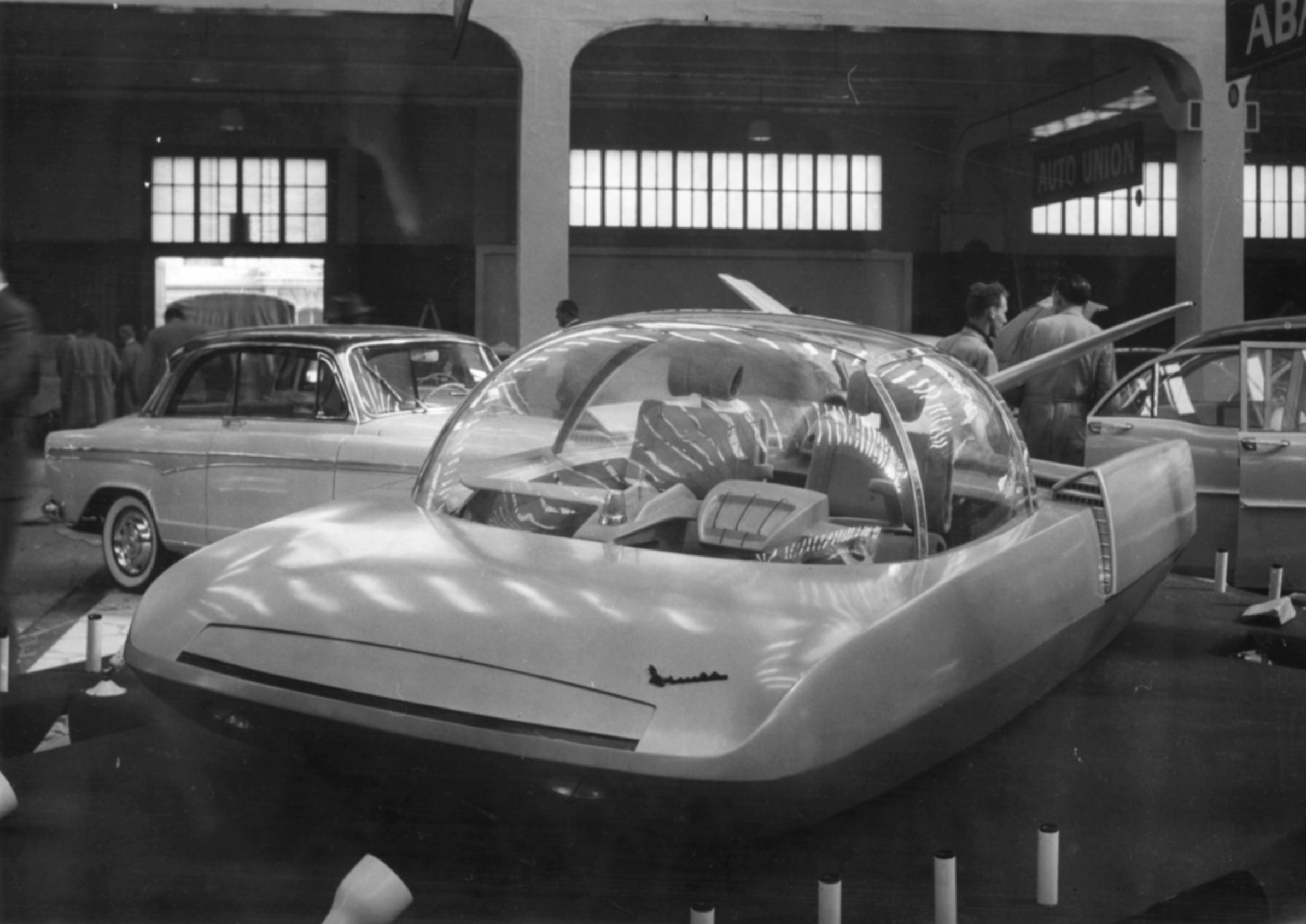
Simca Fulgur
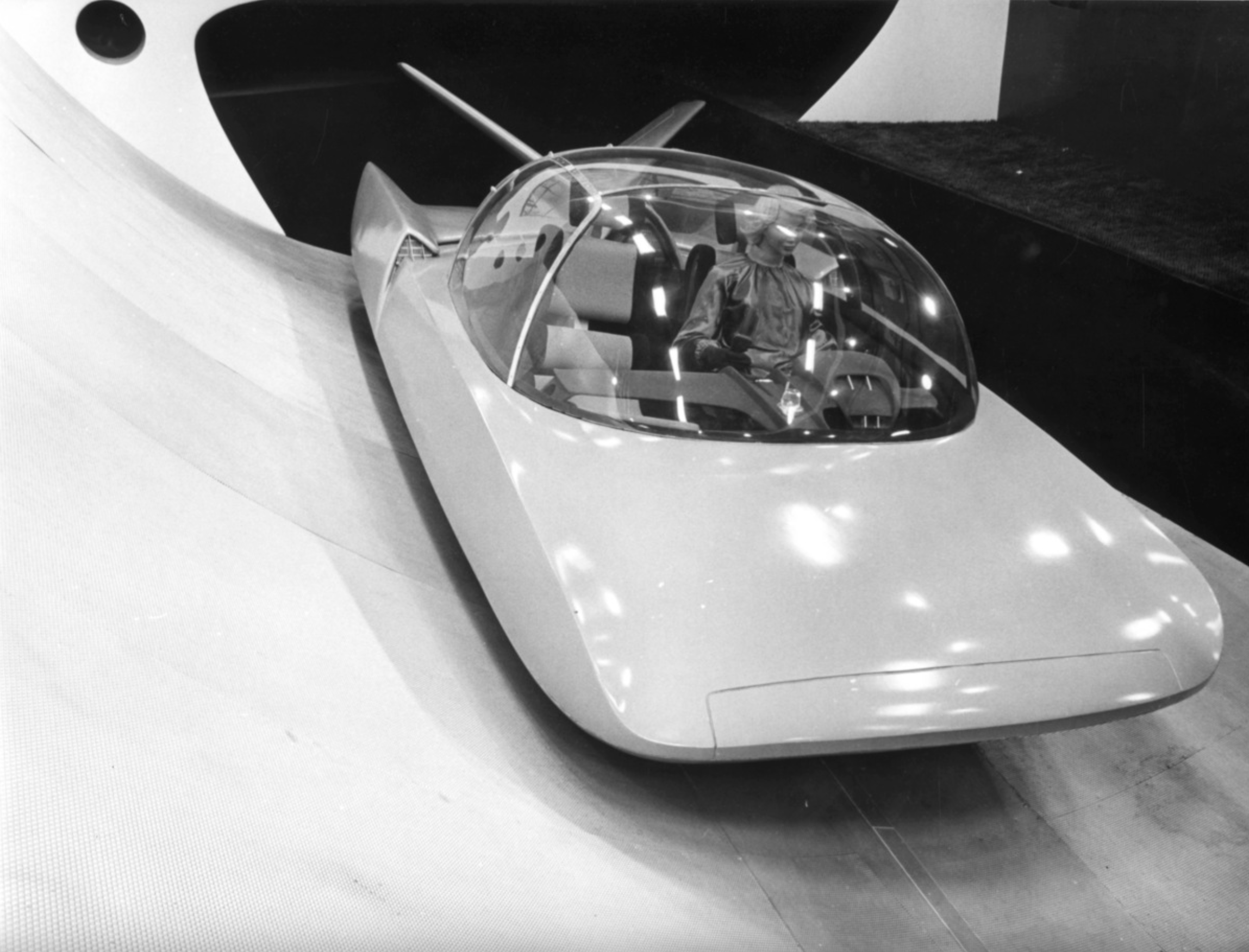
Simca Fulgur
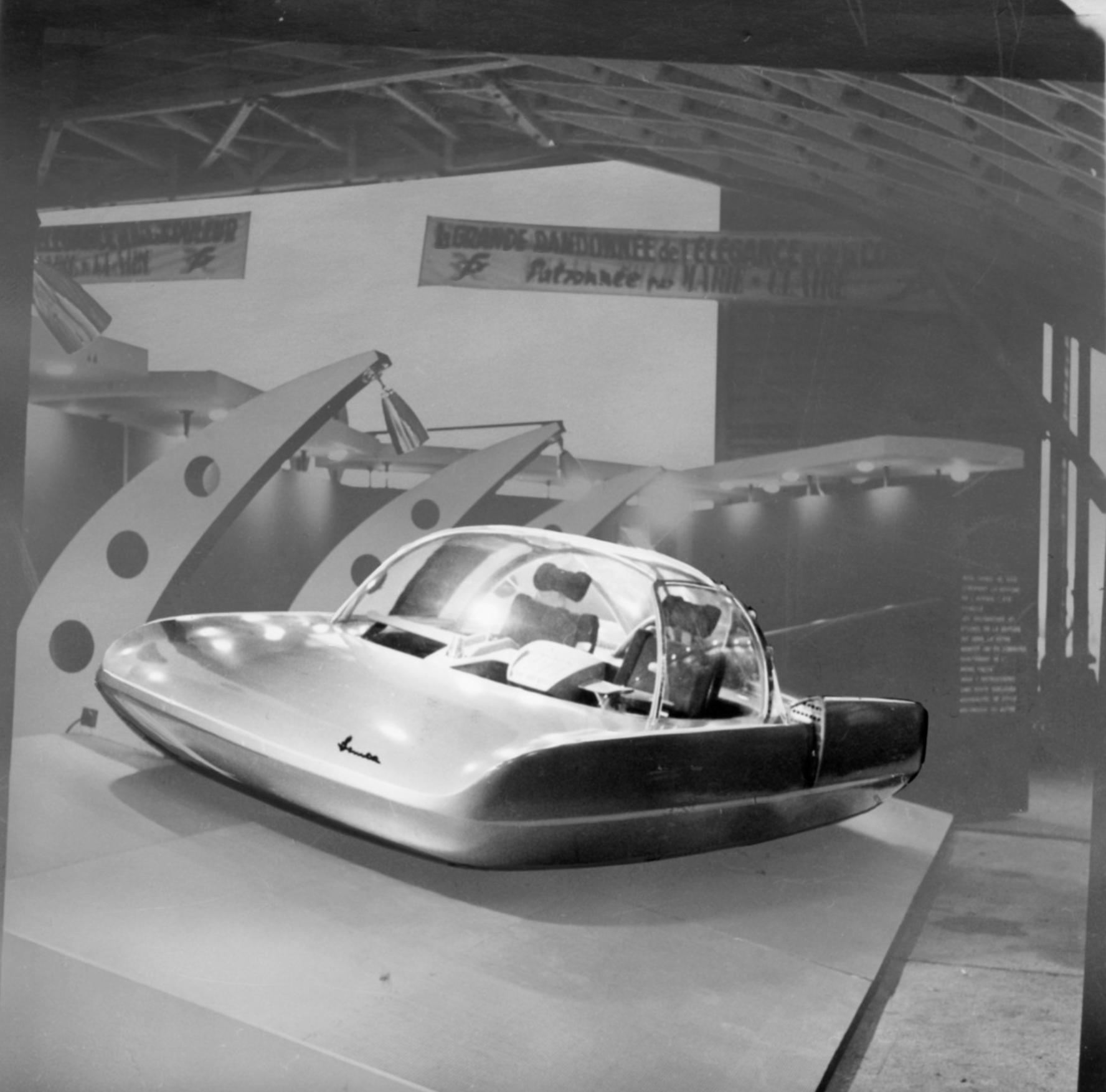
Simca Fulgur
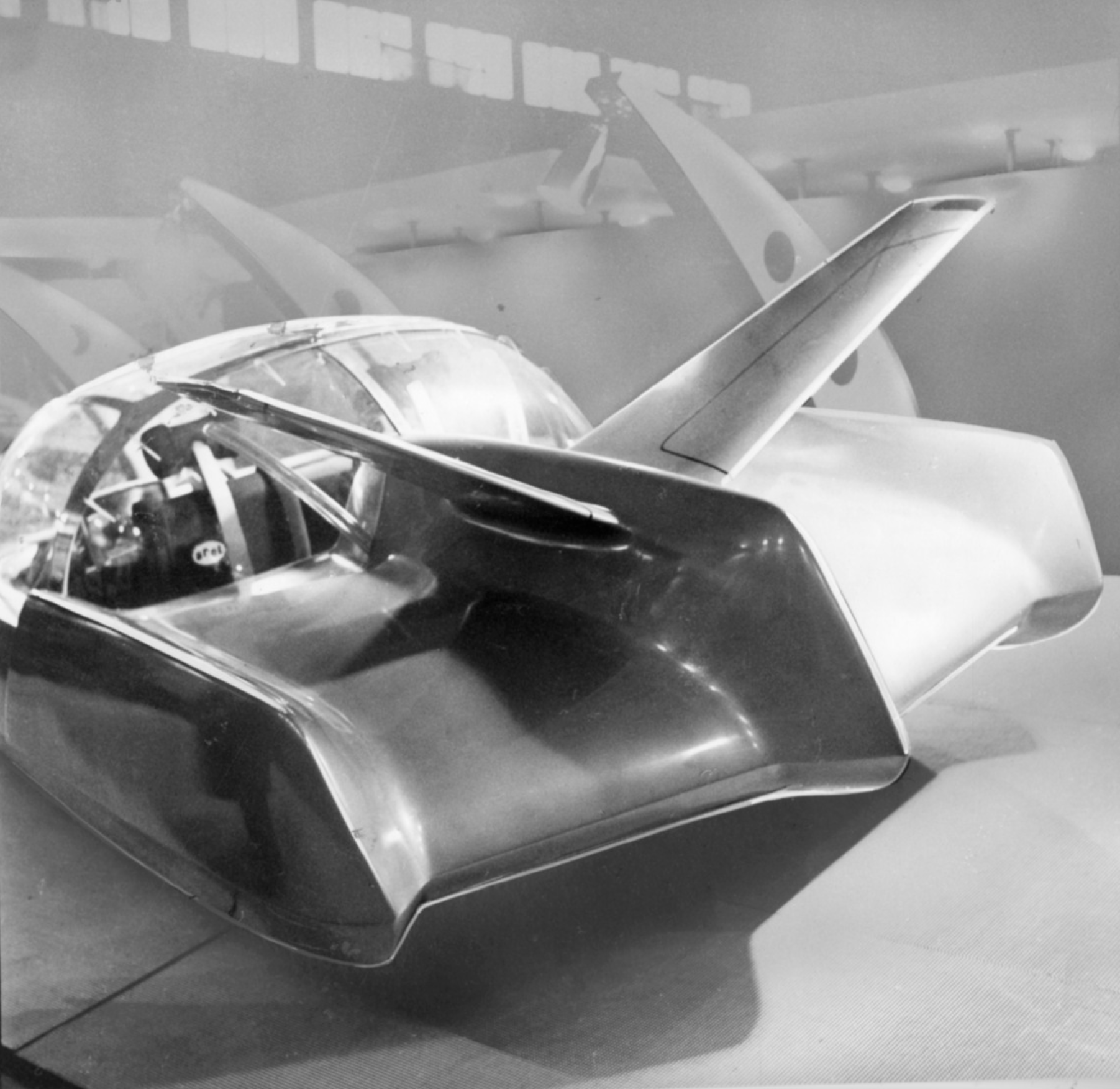
Simca Fulgur
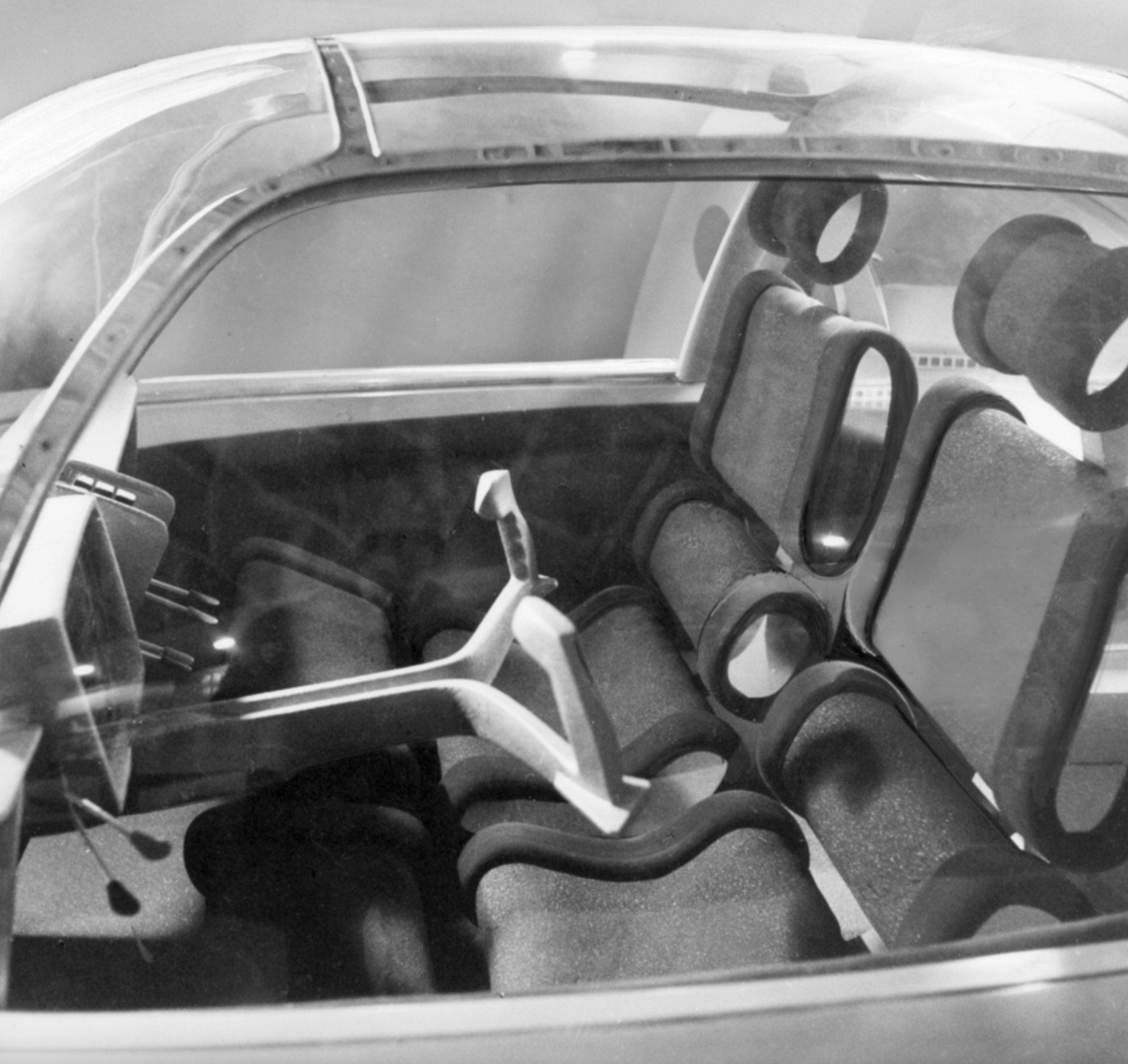
Simca Fulgur
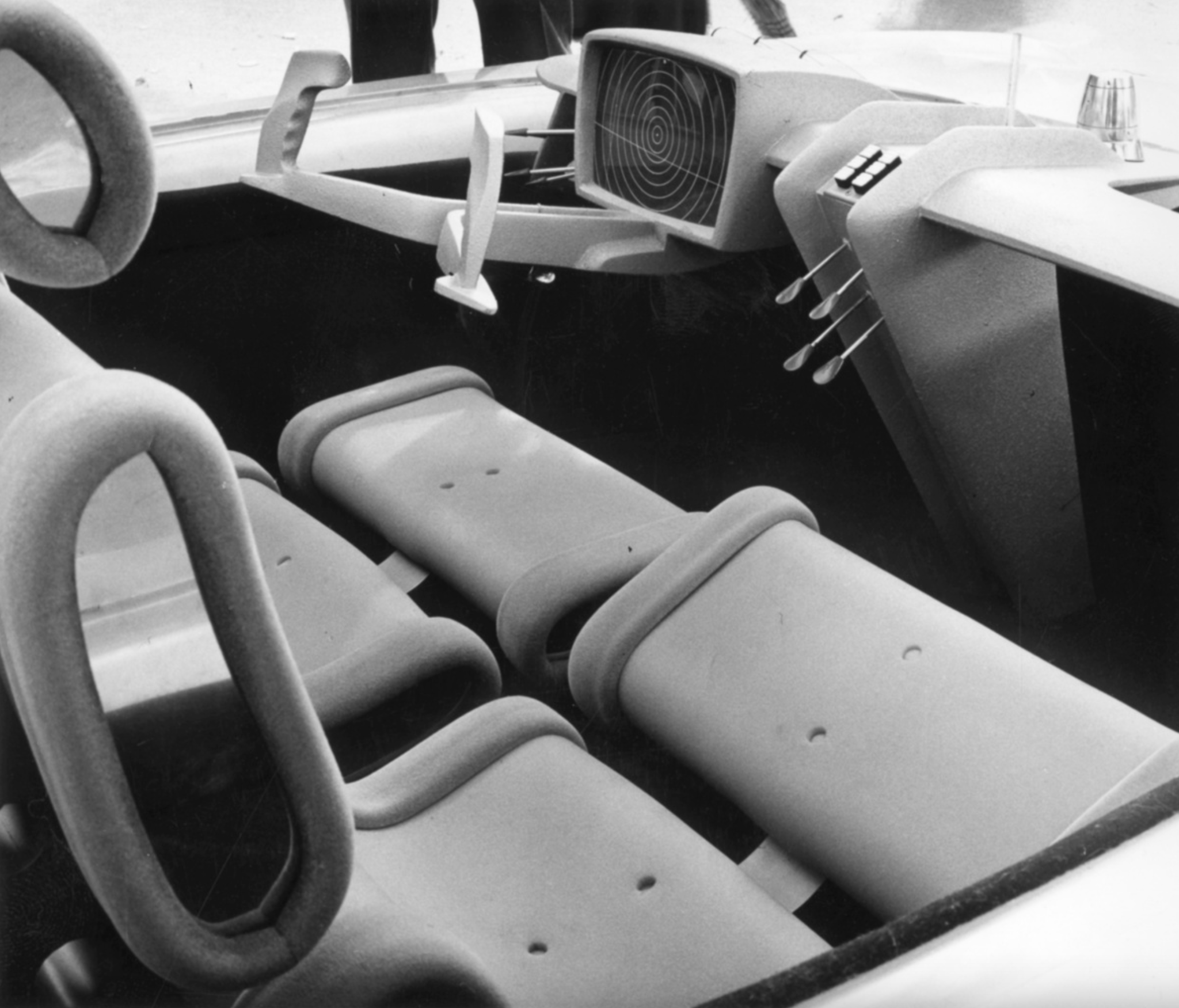
Simca Fulgur

Simca Fulgur
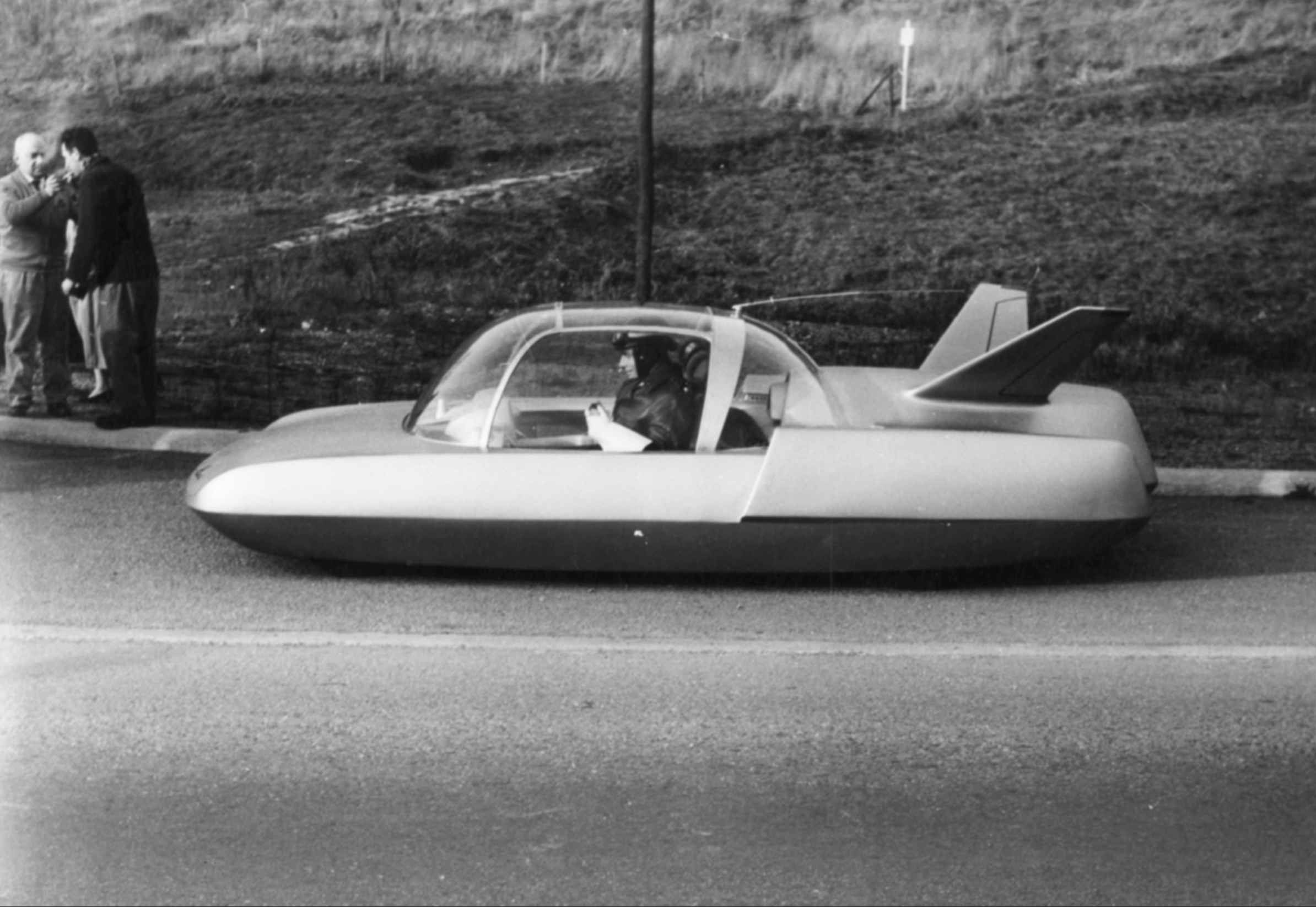
Simca Fulgur
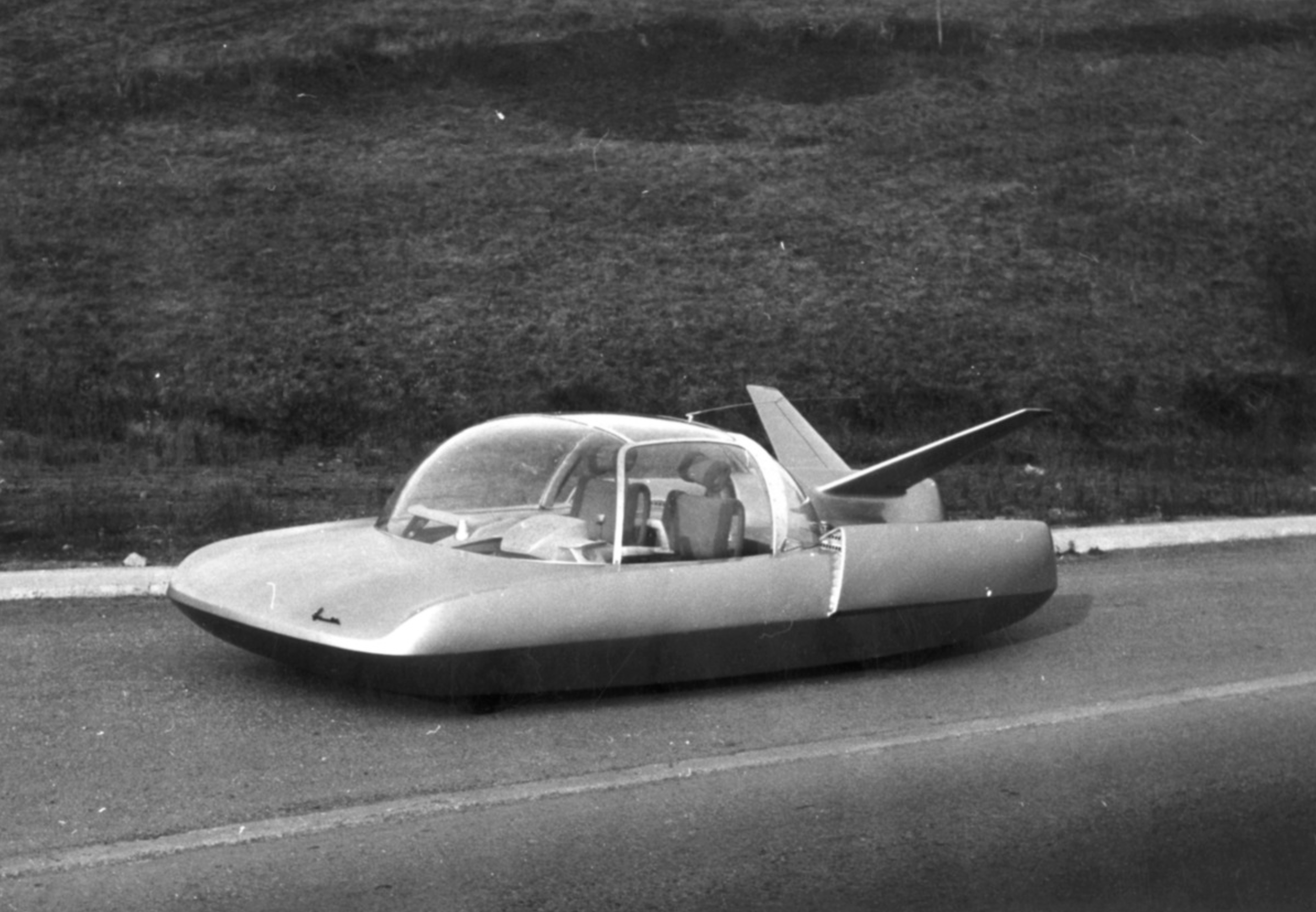
Simca Fulgur
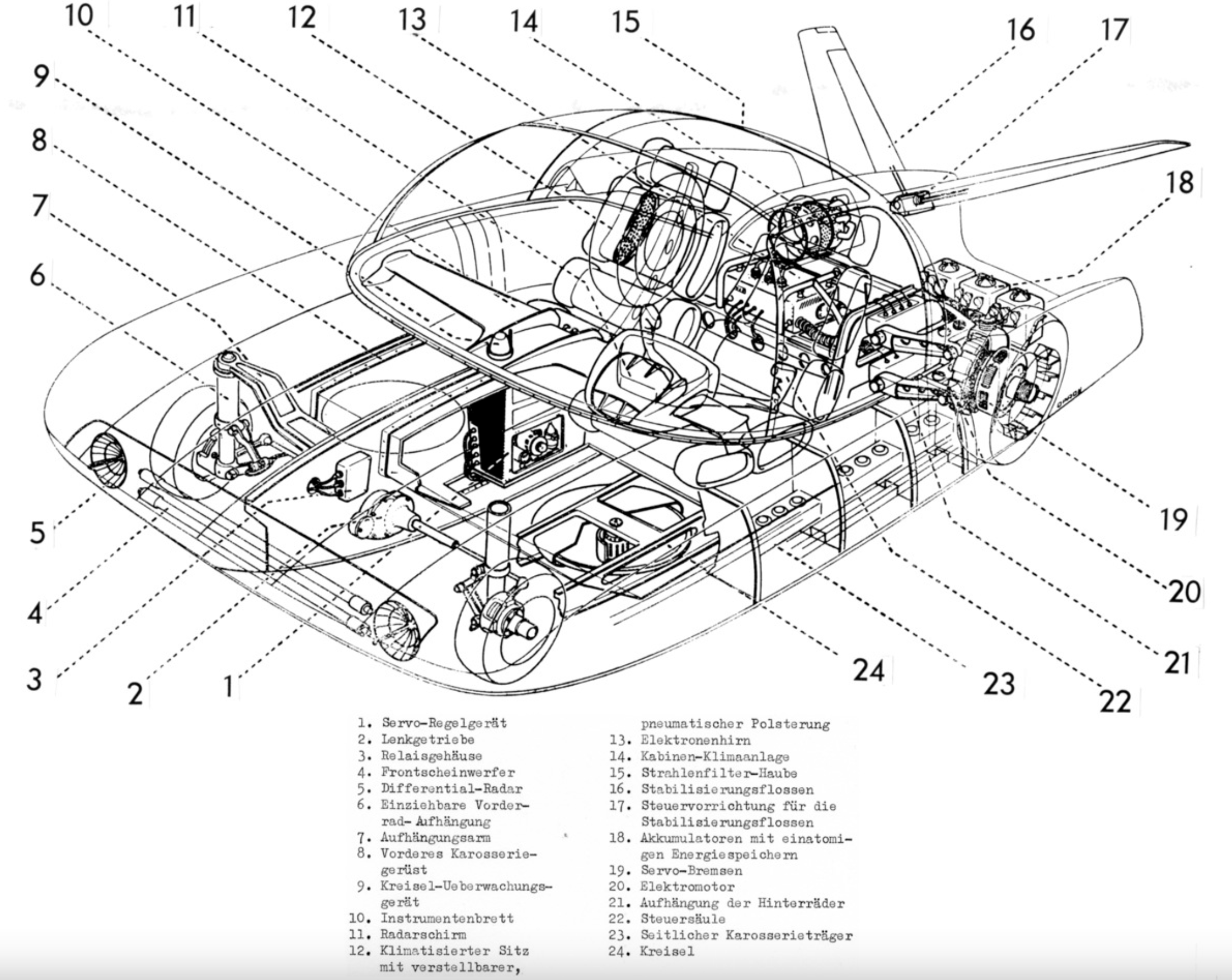
Simca Fulgur
Photos: L’Aventure Peugeot Citroën DS / Terre Blanche / Archives Poissy
